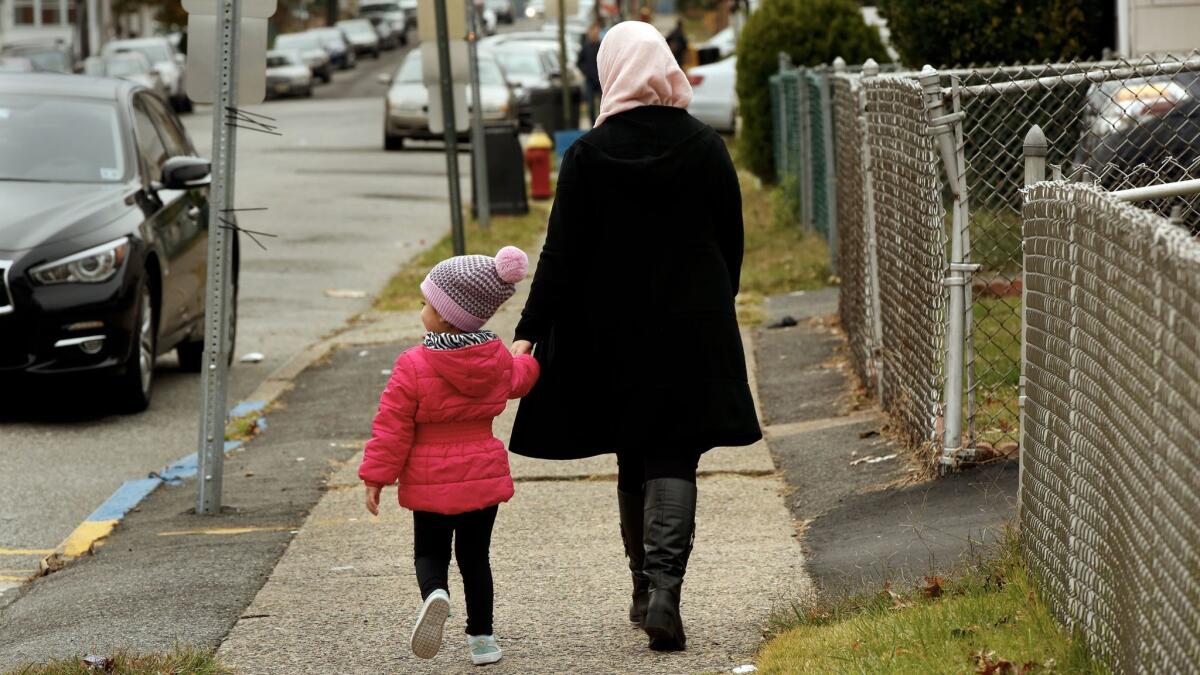New York attack suspect’s family was ‘very mysterious,’ neighbor says

Saipov registered two trucking companies in Ohio before moving to Florida and then New Jersey, where he had been an Uber driver. (Nov. 2, 2017)
Even in a neighborhood packed with immigrants, all with their own customs, languages, foods and idiosyncrasies, there was something about
With the benefit of hindsight, neighbors now believe that the 29-year-old Uzbek immigrant was plotting an attack long before he allegedly plowed his rented truck down a bicycle path in Lower Manhattan, killing eight people.
Three weeks before Tuesday’s attack, a neighbor had noticed that Saipov frequently rented trucks like the one used in the attack.
“This is the kind of truck you use for construction, but he wasn’t doing construction,’’ said Carlos Batista, 23, who noticed that one of the trucks was parked outside a vacant building nearby for nearly a week. “Why would you spend the money to rent this kind of truck and just leave it outside if you’re not using it? … Now I think he was practicing.”

Others were uncomfortable with Saipov’s wife, who wore a niqab, a Muslim garment that reveals only the eyes. Other women among the many Muslims in the neighborhood wear simple head scarves, neighbors say.
“It was unusual around here. You could only see the eyes’’ said Dolores Stanton Vargas, 59, who lives across the street from the neighborhood mosque.
Saipov and his wife, Nozima Odilova, 23, moved about 15 months ago into a scruffy low-rise red-brick building behind the mosque. They had two girls, one now 6 and another 4, and a baby boy who was born about six months ago.
“The wife hardly went out. They were very mysterious,’’ said Altana Dimitrovska, 63, a Macedonian immigrant who lives in the same building. She said that the wife would watch through the curtains of her window as the girls played in the front courtyard, and would occasionally push the baby around the courtyard in a stroller. Saipov was the one who took the older girl to school.
“The girls didn’t have friends. There were no parties,’’ Dimitrovska said.
Language and cultural impediments kept the young family from befriending many people in the neighborhood. But Saipov did have two friends, men who looked similar to him with long beards, who were frequent visitors along with their wives, neighbors said. The wives dressed similarly to Saipov’s wife — wearing the niqab — which made them stick out in the neighborhood.
Over the summer, Batista got into a quarrel with the two visiting men who yelled at him for riding a noisy dirt bike in the evening. Saipov, he said, came out of the apartment and patched up the argument.
“Actually, he was kind of the peacemaker,’’ said Batista. “He seemed pretty nice. After that, he would wave at me when he drove by.’’

The Saipov family was last seen at the apartment complex over the weekend, neighbors said — suggesting that Saipov might have moved his wife to another location in anticipation of the attack. But he rented the pickup truck nearby at a
Saipov immigrated to the United States in 2010 after winning what is called a diversity visa in a lottery designed to bring in immigrants from underrepresented nations. He lived initially with an Uzbek family in Cincinnati who were acquainted with his father. Although he spoke little English, he quickly started working as a truck driver and trying to start his own business. The year after his arrival, he registered his first company, Sayf Motors, at their address in Symmes Township, Ohio, signing the documents of incorporation with the Ohio secretary of state in tidy cursive handwriting.
Two years later, he registered yet another trucking company called Bright Motors at another Ohio address, in Cuyahoga Falls, near Cleveland. He then moved to Tampa, Fla., to start yet another company.
“He always used to work. He wouldn’t go to parties or anything. He only used to come home and rest and leave and go back to work,’’ Dilnoza Abdusamatova, a family friend, told the Cincinnati Enquirer.
Saipov moved frequently. After Cincinnati, he lived near Cleveland, then Tampa, where he obtained his Florida driver’s license. He married his wife, who was 19 years-old at the time of their marriage, in 2013.
Although Saipov seemed purposeful in becoming a driver, there is no indication that he had planned to deploy a truck as a weapon at the time he arrived in the United States. The occupation is common for Uzbek immigrants, who are well represented in the trucking, moving and car services. For the last six months, he was driving an Uber and had logged 1,400 rides, the company confirmed.
A fellow Uzbek immigrant said that there was nothing about Saipov to raise alarms.
“He is very good guy. He is very friendly… He is like little brother… he look at me like big brother,” a friend, Kobiljon Matkarov, told the New York Post. The only thing that stood out as odd was that once, in June, when one of Matkarov’s children asked to take a photo with Saipov, he adamantly refused, he told the Post.

Authorities believe Saipov became more conservative after he arrived in the United States. His neighbors say that his parents, who came to visit from Uzbekistan earlier this year when the baby was born, did not appear to be as devout as their son and that his mother didn’t wear a niqab.
New York Gov. Andrew Cuomo said that Saipov did not have a criminal record other than motor vehicle violations that are common for drivers in the trucking industry.
“After he came to the United States is when he started to become informed about ISIS and radical Islamic tactics,’’ Cuomo said on Wednesday, using an acronym for Islamic State.
“All the evidence we have is that he was a quote unquote lone-wolf model,” Cuomo said. “He has had several run-ins with the law which were basically minor vehicular traffic.”
According to a criminal complaint filed Wednesday in federal court in New York, Saipov decided a year ago to carry out an attack in the United States after being inspired by Islamic State videos he watched on his cellphone. He decided two months ago to use a truck, following online instructions about how a vehicle could be weaponized.
Saipov is now hospitalized with a gunshot wound to the abdomen. “During the interview with law enforcement, Saipov requested to display ISIS’ flag in his hospital room and stated that he felt good about what he had done,’’ the complaint states.
Times staff writer Nina Agrawal contributed to this report.
UPDATES:
3:40 p.m.: This article was updated with additional details about the suspect.
This article was originally published at 8 a.m.
Start your day right
Sign up for Essential California for news, features and recommendations from the L.A. Times and beyond in your inbox six days a week.
You may occasionally receive promotional content from the Los Angeles Times.



